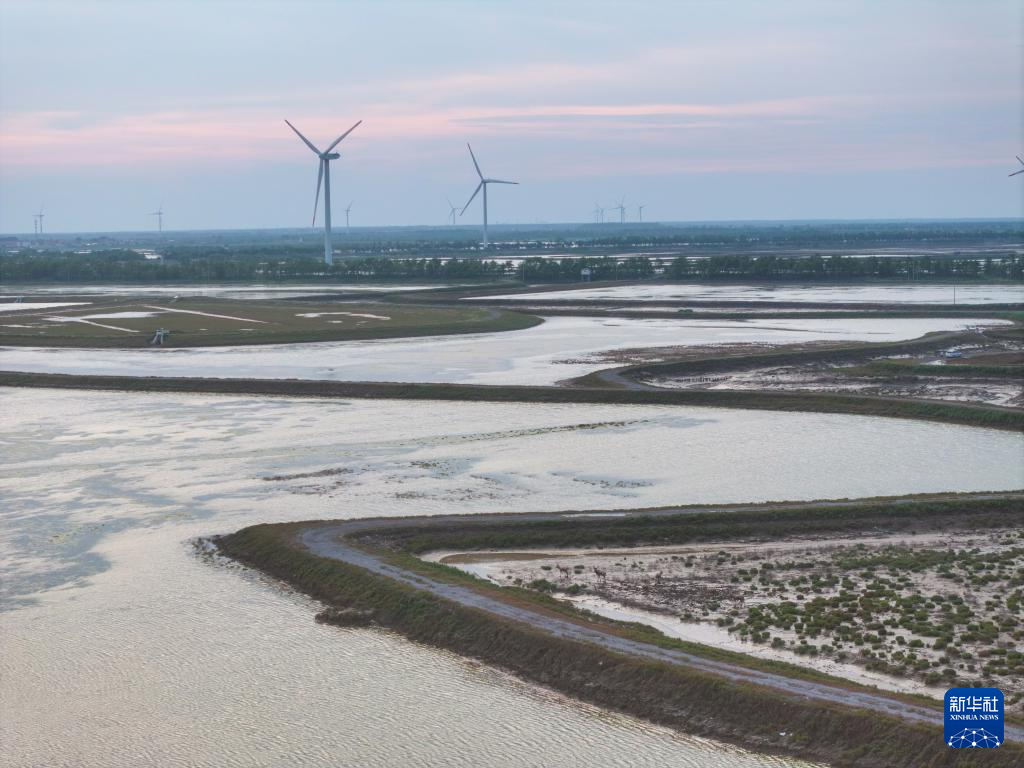Aerial drone photo of Chuanshui Bay taken on August 25.
The Tiaozini Wetland area in Dongtai City, Yancheng, Jiangsu Province, covers a total area of 1.29 million mu. In 2019, it was inscribed on the World Heritage List as a key part of the Migratory Bird Sanctuaries along the Coast of Yellow Sea-Bohai Gulf (Phase I). In recent years, adhering to the “Nature-based Solutions” concept, the Tiaozini Wetland has carried out the Chuanshui Bay coastal ecological protection project. A 720-mu fishpond was specially designated west of the Dongtai seawall to create the country’s first fixed high-tide habitat. The implementation of ecological protection and restoration projects has led to record-high population numbers of some rare species in Tiaozini. Large numbers of waterbirds, herds of elk, and other wild animals have “settled” here, demonstrating initial success in wetland restoration.
Chuanshui Bay
Chuanshui Bay is a scenic coastal area located on the southern coast of Taiwan’s Penghu archipelago. Historically, it was an important anchorage for fishing boats and a site for traditional stone weir fishing, a practice passed down through generations of local fishermen. Today, it is known for its beautiful turquoise waters, unique basalt rock formations, and is a popular spot for tourism and photography.
Tiaozini Wetland
The Tiaozini Wetland is a critical coastal wetland on the eastern side of Jiangsu Province, China, renowned as a major staging area for migratory birds along the East Asian-Australasian Flyway. Historically, it was formed from tidal flats and has been the focus of significant ecological conservation and restoration efforts in recent years to protect its biodiversity.
Dongtai City
Dongtai City is a county-level city in Jiangsu Province, China, with a history dating back over 2,000 years to the Western Han Dynasty. It is historically significant as a center of salt production and is renowned for its location along the UNESCO World Heritage-listed Grand Canal. Today, the city is also known for its vibrant economy and preservation of traditional Huaiyang culture.
Yancheng
Yancheng is a modern coastal city in Jiangsu Province, China, whose name literally means “Salt City,” reflecting its historical significance as a major center for salt production since ancient times. Today, it is known for its extensive wetlands, which serve as a crucial habitat for rare red-crowned cranes and are part of a UNESCO World Heritage site.
Jiangsu Province
Jiangsu Province is a historically significant coastal region in eastern China, renowned as a cradle of Wu culture and for its numerous classical gardens, canals, and silk production. Its history dates back millennia, with its fertile lands along the lower Yangtze River forming the economic and cultural heart of several ancient Chinese dynasties. Today, it remains one of China’s most prosperous provinces, known for its vibrant cities like Nanjing (a former national capital) and Suzhou.
World Heritage List
The World Heritage List is a prestigious international register managed by UNESCO, established in 1972 to identify and protect cultural and natural sites of outstanding universal value. It includes iconic landmarks like the Great Wall of China and the Pyramids of Giza, preserving them for future generations as a common heritage for all humanity.
Migratory Bird Sanctuaries along the Coast of Yellow Sea-Bohai Gulf
The Migratory Bird Sanctuaries along the Coast of Yellow Sea-Bohai Gulf are a UNESCO World Heritage site, recognized for their critical role as a hub for millions of migratory birds traveling the East Asian-Australasian Flyway. The area’s vast intertidal mudflats have formed over millennia from sediment deposits by the Yellow and Yangtze Rivers, creating an exceptionally rich feeding ground. This ecosystem has supported these immense bird populations for centuries and is vital for the survival of numerous threatened species.
Dongtai seawall
The Dongtai Seawall is a historic coastal defense structure in Jiangsu Province, China, originally built during the Song Dynasty (960-1279) to protect low-lying farmland from tidal floods and saltwater intrusion. It represents centuries of human effort to manage the dynamic coastline and remains a significant example of traditional hydraulic engineering in the region.



